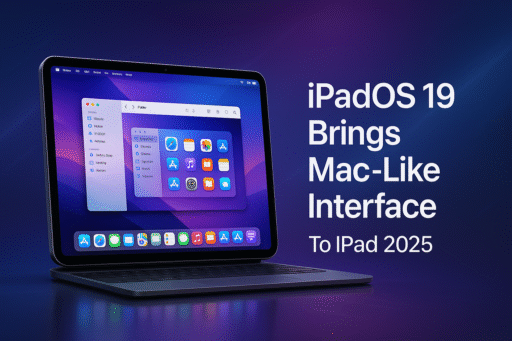For several years, Apple has been pursuing a clear goal: to make the iPad experience as fluid, powerful, and complete as that offered by a Mac. With iPadOS 19, the Californian firm seems to be taking a new decisive step, by offering a major overhaul of its interface. Through a menu bar inspired by macOS and a completely redesigned Stage Manager, Apple intends to strengthen the hybrid aspect of its tablet to attract ever more professionals and demanding users.
A Mac-inspired iPadOS 19 interface
iPadOS 19 could mark a turning point by introducing a menu bar similar to the one Mac users are familiar with. This bar would only appear when the iPad is connected to an external keyboard, like the Magic Keyboard , making the device closer than ever to a traditional laptop.
This new feature aims to streamline navigation between applications and provide easier access to features. Rather than multiplying touch gestures or opening hidden menus, users could find essential options at the top of the screen, always visible. This development seems designed primarily to optimize productivity, particularly in professional settings.
This integration isn’t entirely surprising. Since the arrival of mouse support, then Stage Manager with iPadOS 16, Apple has continued to strengthen the multitasking dimension of its tablets, allowing them to go well beyond simple content consumption.
Stage Manager 2.0: multitasking redesigned
Alongside this new menu bar, iPadOS 19 is expected to feature a significantly improved version of Stage Manager, dubbed Stage Manager 2.0. According to revelations from leaker Majin Bu, known for his often reliable information, this development will allow for even more flexible and intuitive window management.
Stage Manager already allows you to resize and stack multiple windows on an iPad screen, but it remains limited in its approach. Critics pointed to a lack of flexibility in organizing apps, with restrictions that can sometimes be frustrating for users looking to maximize their workspace.
With Stage Manager 2.0, Apple is aiming to offer a more intuitive multitasking experience, allowing you to freely move windows, better organize your virtual desktop, and quickly switch between tasks without losing fluidity. This should greatly improve the use of the iPad for creative or technical professions.
An ambition: to make the iPad a real production tool
Underlying these developments is the same commitment that remains evident at Apple: to transform the iPad into a credible alternative to the PC. Even if the brand communicates this ambition less directly today, its strategic choices speak for themselves.
The arrival of full versions of professional software like Final Cut Pro for video editing, Adobe Photoshop for graphic design, and Logic Pro for music clearly shows that the iPad is now aimed at content creators, artists, and professionals in various sectors.
Additionally, with the iPad’s growing compatibility with external monitors, particularly via Stage Manager, and the improved file manager, Apple is giving users the tools they need to consider the iPad as their primary machine.
Everything suggests that the arrival of new productivity-focused features with iPadOS 19 is part of this long-term strategy. The goal: to no longer confine the iPad to a secondary role, but to make it a central player in users’ workflows.
A new iPad Pro to support this transition
Apple isn’t just improving the software. According to several concurring rumors, including those relayed by Bloomberg via journalist Mark Gurman, a new iPad Pro is also expected to be unveiled by the end of the year. This model will reportedly be equipped with the upcoming M5 processor, offering performance tailored to these ambitious new features.
Such a device would complement the advancements of iPadOS 19 by offering even more powerful hardware, capable of rivaling some MacBooks in terms of speed and graphics capabilities. This combination of hardware and software would finally give substance to Apple’s vision: an iPad capable of meeting the needs of the most demanding professionals without compromise.
It’s also possible that Apple will refine other aspects of the system, such as improving support for split-screen applications, advanced multi-user management, or better integrated collaborative tools.
iPadOS 19: towards an ever more hybrid iPad
The arrival of a menu bar, a more powerful Stage Manager 2.0 and a new iPad Pro confirms a clear trend: the iPad is increasingly becoming a hybrid device, capable of adapting to users’ desires.
This evolution is part of a growing demand for powerful and versatile mobile work tools . In a world where remote working, mobile content creation and the need for flexibility are booming, Apple intends to make the iPad the essential tool for combining mobility and productivity.
It remains to be seen whether these changes will be enough to convince those still undecided between buying a Mac or an iPad. What is certain is that with iPadOS 19, Apple continues to blur the lines between tablet and laptop, offering an ever more seamless user experience tailored to today’s needs.




